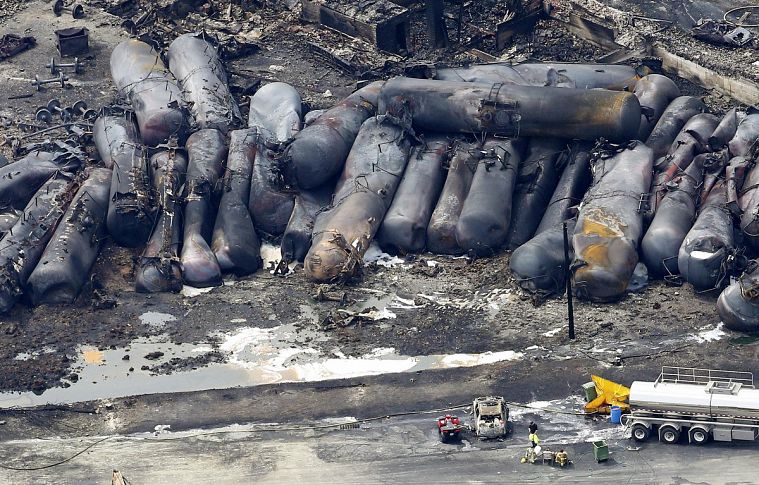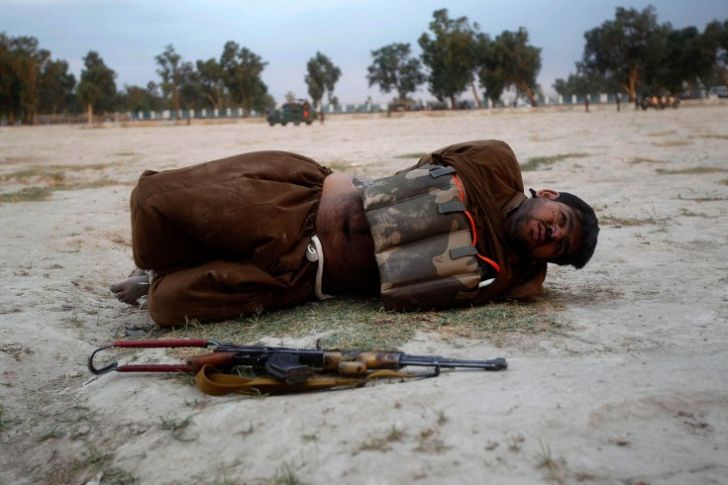Notes
Mineral, Vegetable and Animal: after the Quebec Tank Car Explosion, Robert Hariman’s Meditation on Oil
The caption at Reuters referred to “the remains of a train wreckage,” and it is that. The train of tank cars carrying crude oil had exploded in Lac Megantic, Quebec, creating an inferno that killed at least 15 people, with others yet to be accounted for. This human toll should not be minimized, and I will be among the last to grieve over the loss of company property. Nonetheless, the photo above deserves attention even as it takes us in away from those whose lives were torched by the blast.
The scorched tank cars look like carcasses more than anything else. Like the bloated bodies of pigs after a flood, or dead fish after an oil spill in a river. Or, if you like sci fi noir, like pods leaking alien spoor in some industrial wasteland of a long dead planet. The sense of scale is all off–certainly not to human scale, as the tanker truck and other vehicles on the road are dwarfed by the giant metal rames piled up like so much slag at a gargantuan mill.
But I keep coming back to a sense of organic life now dead. As if some life form has been decimated arbitrarily, accidentally, without dignity or purpose. Again, I know that human beings really did suffer that death, but nonetheless I think this photograph captures something important about the larger economy of life and death in a machine age.
The word “petroleum” comes from the Greek petra/rock and Latin oleum/oil, and that etymology captures the sense of being both inorganic and organic. Technically, oil is not a mineral, yet oil rights are covered under mineral rights, it is pumped out of the dark depths of the earth, and then it is turned into tens of thousands of materials and other products. Likewise, the black (and blackened) steel tanker cars represent the black oil they carried, as if two parts of the same whole. Thus, oil can be thought of as a mineral that once was a mixture of plants and other decomposing matter, and perhaps the photo taps into that deep organic history. Plants and animals were transformed over vast expanses of geological time into the crude oil that then was used in just over a century of industrialized production to support an incredible expansion of human development, but one not without its costs. And that process of oil extraction, distribution, refining, and conversion into machine power increasingly seems to have developed a life of its own, or at least a great many defenders of its right to exist and expand without limit. But as the photograph above suggests, even that process can come full circle, destroying its own and leaving nothing but waste that will be much less likely in the long run to change into anything else.
I’ve always enjoyed the family road trip game of Twenty Questions, where you start by asking if the object is Animal, Vegetable, or Mineral. For the time spent trapped in the car, we could at least share the illusion that all the world could be placed neatly into one of three categories, and with everything either bigger, smaller, or (less often) the same size as a breadbox. Without cheap gasoline, I doubt we would have played the game. At the same time, we were being driven toward a world where those simple categories were going to become increasingly intertwined.
Look again: the tanker cars are at once bigger and smaller than a breadbox. More important, or less a trick of the eye, they also are at once vegetable, mineral, and animal. And so, as this photograph senses, there may be something to mourn there after all. But just what that is, exactly, I’m not sure.
— Robert Hariman
(cross-posted from No Caption Needed)
(photo: Mathieu Belanger/Reuters)


Reactions
Comments Powered by Disqus